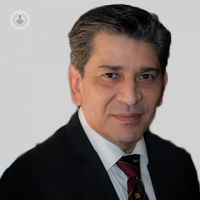Facial implants
Mr Peyman Alam - Oral & maxillofacial surgery
Created on: 11-13-2012
Updated on: 07-25-2023
Edited by: Karolyn Judge
What are facial implants?
Facial implants are solid and voluminous implants that are used to modify the size of different areas of the face in order to harmonise the features. The most commonly used are facial implants for the chin, cheekbones, lips, jaw, forehead and the cleft above the upper lip (philtrum).
Many types of facial implants are available, and in a variety of materials including silicone and biologic and synthetic fillers. They are usually implanted under general anaesthetic although, depending on the case, local anaesthetic may be used on its own or combined with sedation.

Why are they used?
Facial implants are used in oral and maxillofacial surgery and in plastic, aesthetic and reconstructive surgery to improve the proportion and enhance certain features of the face, to correct a congenital malformation, or to rehabilitate or replace structures and parts of the face that have been disfigured by trauma, injuries or accidents.
The craniofacial implants used in maxillofacial and reconstructive surgery are inserted into the relevant area to:
- Correct the jaw structure or jawline, which could cause chewing problems if not addressed.
- Improve bone anchorage, by bringing the chin or cheekbones forward, for example
- Improve the appearance of the cheeks
- Reconstruct a disfigured part of the face, etc.
Depending on the objective of the facial implants and the complexity of the case, it may be necessary to use a combination of implants and prostheses to reconstruct the affected area.
To a lesser extent, these implants can also be used to conceal wrinkles, acne scars and other skin imperfections.
What does implant surgery involve?
Facial implant surgery should be performed in hospital or in a specialist clinic, usually under general anaesthetic.
The surgical procedure varies depending on the area to be treated: for example, for chin and jaw implants the surgeon will make an incision inside the mouth or under the chin to insert the implants, and an incision below the cheeks for cheek implants.
The surgery is performed on an outpatient basis and lasts approximately one hour, so you will be discharged and can return home within a few hours.
What's involved in preparation for facial implants?
This is an outpatient surgery, but if performed under general anaesthetic you should follow the specialist’s instructions regarding the kind of food and drink you can have before the operation.
You should also inform the specialist if you smoke or if you have any dental problems, as these may affect the operation.
It is important that you have someone to accompany you home after the operation.
What's involved in post-operative care?
It is common to have bruising and swelling in the treated area after facial implant surgery, but this will start to gradually disappear after a few weeks.
You will be able to go home a few hours after the operation and return to work after a week. The swelling will disappear completely after four to six months and you will see the definitive result.
After surgery, you will be given antibiotics to prevent infection and you must not drink alcohol. For the first few weeks you should avoid contact sports and activities where there is a risk of impact.
What are the different facial implant options?
The greatest advance in facial implants has been in the material used to make them.
They were initially made of wax or ivory, and later also made of plastic materials. Today, silicone is a common material. Some facial implants are made from biocompatible materials such as collagen and hyaluronic acid derivatives.
These implants are resorbable, so the result is not permanent. After approximately 12 to 18 months the body reabsorbs them and they disappear.
They are an alternative for people who want to improve the harmony of their face but do not want the implant to be permanent, as the shape of the face and the skin change with age.




